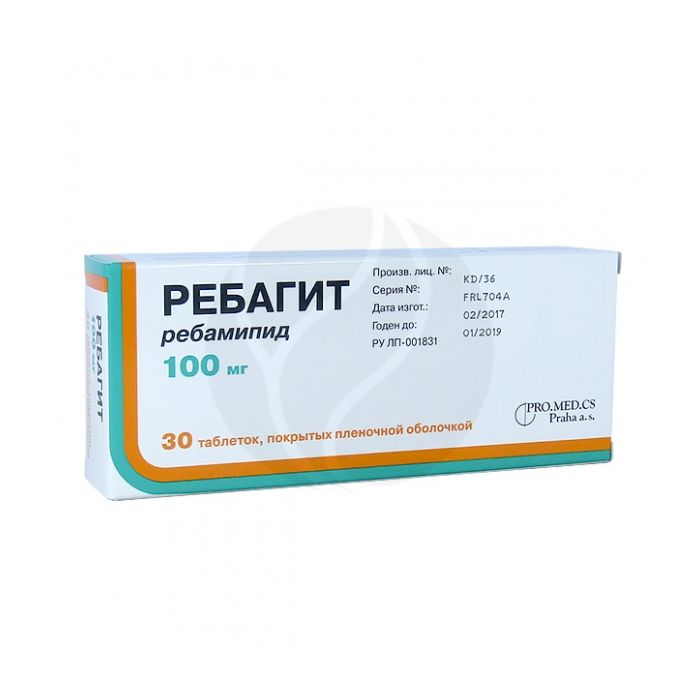Rebagit tablets p / o 100mg, No. 30
Expiration Date: 11/2025
Russian Pharmacy name:
Ребагит таблетки п/о 100мг, №30
stomach ulcer;
chronic gastritis with increased acid-forming function of the stomach in the acute phase, erosive gastritis;
prevention of damage to the mucous membrane while taking NSAIDs.
Can be used in combination therapy.
Inside, 1 tablet 3 times / day with a small amount of liquid. The course of treatment is 2-4 weeks, if necessary, it can be extended up to 8 weeks.
The drug has no peculiarities of action when taken for the first time or when it is canceled.
If you skip taking one dose, you must take the next dose of the drug at the set time, you should not take a double dose of the drug.
Rebamipide - 100 mg
Excipients: mannitol - 35.7 mg, croscarmellose sodium - 14 mg, pregelatinized starch - 80.7 mg, sodium lauryl sulfate - 2 mg, citric acid - 2.3 mg, purified talc - 3.1 mg, magnesium stearate - 2.2 mg.
The composition of the film shell: hypromellose - 2.77 mg, purified talc - 0.57 mg, titanium dioxide - 1.11 mg, propylene glycol - 0.55 mg.
individual intolerance to ribamipide or other components of the drug;
pregnancy;
lactation period;
age up to 18 years.
Film-coated tablets of white or almost white color, round, biconvex.
Composition:
Active substance:
Rebamipide - 100 mg
Excipients: mannitol - 35.7 mg, croscarmellose sodium - 14 mg, pregelatinized starch - 80.7 mg, sodium lauryl sulfate - 2 mg, citric acid - 2.3 mg, purified talc - 3.1 mg, magnesium stearate - 2.2 mg.
The composition of the film shell: hypromellose - 2.77 mg, purified talc - 0.57 mg, titanium dioxide - 1.11 mg, propylene glycol - 0.55 mg.
Clinical and pharmacological group: Gastroprotector
Pharmaco-therapeutic group: Gastroprotective agent
pharmachologic effect
Rebamipide increases the content of prostaglandin E2 (PGE2) in the gastric mucosa and increases the content of PGE2 and GI2 in the gastric juice. Has a cytoprotective effect on the gastric mucosa under the damaging effects of ethanol, acids and alkalis, acetylsalicylic acid. Promotes the activation of enzymes that accelerate the biosynthesis of high molecular weight glycoproteins, and increases the mucus content on the surface of the stomach wall. It improves the blood supply to the gastric mucosa, activates its barrier function, activates the alkaline secretion of the stomach, enhances the proliferation and exchange of epithelial cells of the stomach, cleans the mucosa from hydroxyl radicals and suppresses superoxides produced by polymorphonuclear leukocytes and neutrophils in the presence of Helicobacter pylori, protects the mucous membrane of the stomachhas a gastroprotective effect when exposed to the mucous membrane of NSAIDs.
Pharmacokinetics
Absorption and distribution
After taking a dose of 100 mg, Cmax is reached after about 2 hours and is 340 ng / ml. Repeated doses of the drug do not lead to its accumulation in the body.
In vitro experiments have shown that from 98.4% to 98.6% of the drug binds to plasma proteins.
Metabolism and excretion
T1 / 2 is approximately 1.0 h. Approximately 10% of the drug is excreted by the kidneys, mainly unchanged. When taken in a dose of 600 mg, traces of the hydroxylated metabolite can be isolated.
Indications
stomach ulcer;
chronic gastritis with increased acid-forming function of the stomach in the acute phase, erosive gastritis;
prevention of damage to the mucous membrane while taking NSAIDs.
Can be used in combination therapy.
Dosage regimen
Inside, 1 tablet 3 times / day with a small amount of liquid. The course of treatment is 2-4 weeks, if necessary, it can be extended up to 8 weeks.
The drug has no peculiarities of action when taken for the first time or when it is canceled.
If you skip taking one dose, you must take the next dose of the drug at the set time, you should not take a double dose of the drug.
Side effect
From the digestive system: constipation, flatulence, diarrhea, nausea, vomiting, abdominal pain, impaired taste, heartburn.
From the liver: signs of liver dysfunction, increased serum ALT and ACT.
From the hematopoietic system: leukopenia, granulocytopenia.
Others: menstrual irregularities.
Contraindications for use
individual intolerance to ribamipide or other components of the drug;
pregnancy;
lactation period;
age up to 18 years.
Application during pregnancy and lactation
The safety of using rebamipide during pregnancy has not been proven. Do not use during pregnancy.
Since rebamipide is excreted in breast milk, breastfeeding should be discontinued or the issue of artificial feeding of the baby should be decided if it is necessary to prescribe rebamipide to the mother during breastfeeding.
Application in children
Contraindicated in children under 18 years of age.
Use in elderly patients
At the first appointment of rebamipide to elderly patients due to the possibility of hypersensitivity to the drug.
special instructions
Influence on the ability to drive vehicles and mechanisms
The effect of the drug on the speed of psychomotor reactions and / or the ability to drive vehicles or mechanisms has not been studied. In the case of taking the drug, you should be careful about driving a car and other activities that require increased concentration of attention.
Overdose
Symptoms of an overdose with rebamipide have not been described, and to date, no cases of deliberate overdose have been reported. Possible nausea, vomiting, abdominal pain, diarrhea or constipation, headache.
Treatment: the specific antidote is unknown. In case of an overdose, the stomach should be flushed and symptomatic therapy should be carried out.
Drug interactions
When rebamipide is used as part of traditional therapy regimens for patients with Helicobacter pylori infection, the effectiveness of eradication therapy significantly increases.
Interaction reactions with other drugs have not been studied.
Storage conditions
The drug should be stored out of the reach of children, dry, protected from light, at a temperature not exceeding 25 ? C.
Shelf life
Shelf life is 2 years.
Terms of sale
The drug is available with a prescription.
No special precautions are required for the destruction of an unused or expired medicinal product.

